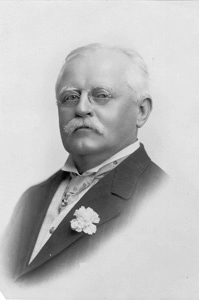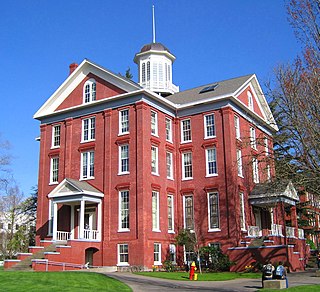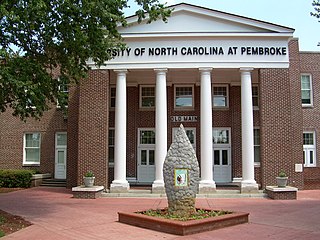
The University of North Carolina at Chapel Hill is a public research university in Chapel Hill, North Carolina. It is the flagship of the University of North Carolina system. After being chartered in 1789, the university first began enrolling students in 1795, making it one of the oldest public universities in the United States.

Marycrest College Historic District is located on a bluff overlooking the West End of Davenport, Iowa, United States. The district encompasses the campus of Marycrest College, which was a small, private collegiate institution. The school became Teikyo Marycrest University and finally Marycrest International University after affiliating with a private educational consortium during the 1990s. The school closed in 2002 because of financial shortcomings. The campus has been listed on the Davenport Register of Historic Properties and on the National Register of Historic Places since 2004. At the time of its nomination, the historic district consisted of 13 resources, including six contributing buildings and five non-contributing buildings. Two of the buildings were already individually listed on the National Register.

The Old Well is a small, neoclassical cyclostyle on the University of North Carolina at Chapel Hill campus at the southern end of McCorkle Place. The current decorative form of the Old Well was modeled after the Temple of Love in the Gardens of Versailles and was completed in 1897. It was designed by the university registrar Eugene Lewis Harris (1856-1901), an artist and 1881 graduate of the institution, who served as registrar from 1894 to 1901. It is the most enduring symbol of UNC.
PlayMakers Repertory Company is the professional theater company in residence at the University of North Carolina at Chapel Hill. PlayMakers Repertory Company is the successor of the Carolina Playmakers and is named after the Historic Playmakers Theatre. PlayMakers was founded in 1976 and is affiliated with the Dramatic and performing arts at the University of North Carolina at Chapel Hill. The company consists of residents, guest artists, professional staff and graduate students in the Department for Dramatic Arts at UNC and produces seasons of six main stage productions of contemporary and classical works that run from September to April. PlayMakers Repertory Company has a second stage series, PRC², that examines controversial social and political issues. The company has been acknowledged by the Drama League of New York and American Theatre magazine for being one of the top fifty regional theaters in the country. PlayMakers operates under agreements with the Actors' Equity Association, United Scenic Artists, and the Society of Stage Directors and Choreographers.

Julian Shakespeare Carr was an American industrialist, philanthropist, and white supremacist. He is the namesake of the town of Carrboro, North Carolina.

Connecticut Hall is a Georgian building on the Old Campus of Yale University. Completed in 1752, it was originally a student dormitory, a function it retained for 200 years. Part of the first floor became home to the Yale College Dean's Office after 1905, and the full building was converted to departmental offices in the mid-twentieth century. It is currently used by the Department of Philosophy, and its third story contains a room for meetings of the Yale Faculty of Arts & Sciences, the academic faculty of Yale College and the Graduate School.

Old Queens is the oldest extant building at Rutgers University and is the symbolic heart of the university's campus in New Brunswick in Middlesex County, New Jersey in the United States. Rutgers, the eighth-oldest college in the United States, was founded in 1766 during the American colonial period as Queen's College. Queen's College was named for Charlotte of Mecklenburg-Strelitz, the daughter of a German duke who became the queen consort of British king George III. Old Queens is located on a six-acre hilltop city block bounded by Somerset Street, Hamilton Street, College Avenue and George Street that was previously an apple orchard. Donated to the college in 1807 by James Parker, Jr., this city block become known the Queen's Campus and is the historic core of the university. Because of this, by metonymy, the name "Old Queens" came to be used as a reference to Rutgers College and is often invoked as an allusive reference to the university or to its administration.

Waller Hall is a building on the campus of Willamette University in Salem, Oregon, in the United States. Opened in 1867 as University Hall, it is the oldest higher-education building west of the Mississippi River still in use, currently housing the university's administrative offices.

The Playmakers Theatre, originally Smith Hall, is a historic academic building on the campus of the University of North Carolina at Chapel Hill. Built in 1850, it was designated a National Historic Landmark for its architecture, as an important example of Greek Revival architecture by Alexander Jackson Davis. It is now a secondary venue of the performing company, which is principally located at the Paul Green Theatre in the Joan H. Gillings Center for Dramatic Art.

The Pope House Museum, built in 1901, is a restored home once owned by Dr. Manassa Thomas Pope, a prominent African-American citizen of Raleigh, North Carolina. The Pope House is listed on the National Register of Historic Places in 1999, It was an official project of the Save America’s Treasures Program and the city of Raleigh took over management of it, offering tours for the first time in 2012.

Maybury Hill is a historic house at 346 Snowden Lane, in Princeton, Mercer County, New Jersey, United States. Built about 1725, it was the birthplace and boyhood home of Joseph Hewes (1730-1799), a signer of the United States Declaration of Independence. The house, an architecturally excellent example of Georgian domestic architecture, was designated a National Historic Landmark in 1971 for its association with Hewes. It is a private residence not open to the public.

Peace College Main Building is the focal point of the Peace College campus in Raleigh, North Carolina. Built between 1859 and 1862, Main Building is located at the northern end of Wilmington Street in downtown Raleigh and is considered one of the largest antebellum buildings surviving in the city. During its early history, Main Building was used as a military hospital and offices for the Freedmen's Bureau. The building now contains offices, parlors, banquet rooms, and dormitory residences. Main Building was listed on the National Register of Historic Places in 1973 and is a designated Raleigh Historic Landmark.

The University of North Carolina at Chapel Hill is a coeducational public research university located in Chapel Hill, North Carolina, United States. It is one of three schools to claim the title of the oldest public university in the United States. The first public institution of higher education in North Carolina, the school opened on February 12, 1795.

McMillan Hall is a building on the campus of Washington & Jefferson College in Washington, Pennsylvania, United States. Built in 1793, it is the only surviving building from Washington Academy. It is the eighth-oldest academic building in the United States that is still in use for its original academic purpose and is the oldest surviving college building west of the Allegheny Mountains.

Over 8,000 undergraduate and graduate students live in campus housing at the University of North Carolina at Chapel Hill during a regular school year. Forty residence halls are grouped into 16 residential communities across campus.
John Sprunt Hill was a North Carolina lawyer, banker and philanthropist who played a fundamental role in the civic and social development of Durham, North Carolina, the expansion of the University of North Carolina at Chapel Hill and the development of rural credit unions in North Carolina during the first half of the 20th century.

The Queens Campus or Old Queens Campus is a historic section of the College Avenue Campus of Rutgers, The State University of New Jersey in New Brunswick, New Jersey, in the United States.

Carolina Hall, formerly known as Saunders Hall, is a building on the University of North Carolina at Chapel Hill campus in Chapel Hill, North Carolina, in the United States. Carolina Hall was built in 1922 and named for William L. Saunders, an alumnus and a colonel in the Confederate States Army during the American Civil War. The name was changed to "Carolina Hall" in 2015.

Young Men's Institute Building, also known as the YMI Building, is a historic meeting hall located at Asheville, Buncombe County, North Carolina. It was designed by architect Richard Sharp Smith and built in 1892–1893. It is a 2+1⁄2-story, pebbledash coated masonry building with brick, stone, and wood accents. From its early days, the YMI building has housed shops, residence rooms, meeting rooms, and a wide variety of functions serving the African American community of Asheville. The building was restored and reestablished as the YMI Cultural Center in 1980, and now hosts a variety of intercultural programs and events. It is located in the Downtown Asheville Historic District.

The Old Main is a historic building on the campus of the University of North Carolina at Pembroke in Pembroke, North Carolina. Completed in 1923, it was the first brick building on the university's campus, then known as the Cherokee Indian Normal School of Robeson County. The building originally hosted classrooms, auditorium space, and administrative offices. After administrative officials moved to a new building in 1949, the structure acquired the "Old Main" name. Since it was used for other community events, it gained additional importance to the primarily Native American student body at the school. Old Main was slated for destruction in 1972, but this decision was overturned after protests by community members. A fire, likely the result of arson, gutted the building in 1973. It was listed on the National Register of Historic Places in 1976 and fully restored and reopened in 1979. It presently hosts several university departments and student media outlets.























